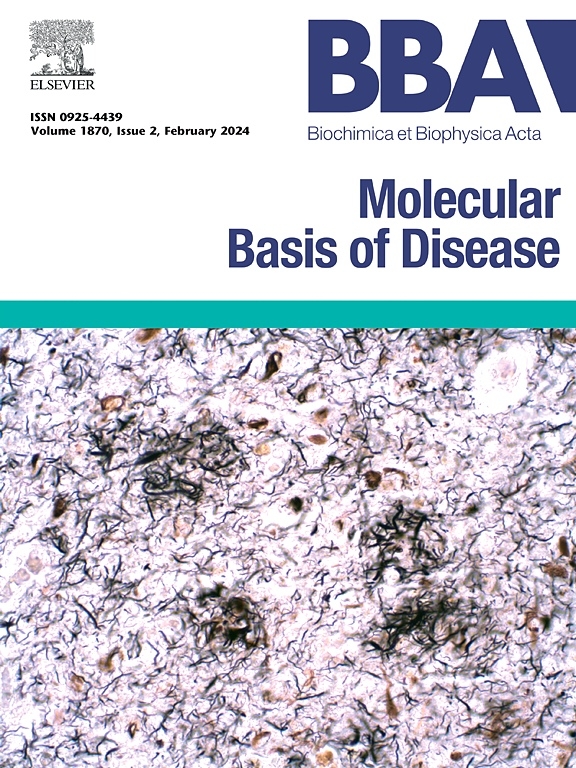The involvement of YAP-TGFβ-SMAD-mediated fibrosis in primary inferior oblique overaction
IF 4.2
2区 生物学
Q2 BIOCHEMISTRY & MOLECULAR BIOLOGY
Biochimica et biophysica acta. Molecular basis of disease
Pub Date : 2024-12-09
DOI:10.1016/j.bbadis.2024.167620
引用次数: 0
Abstract
This study investigates the involvement of fibrosis in primary inferior oblique overaction (PIOOA), a strabismus characterized by excessive upward eye rotation. First, we identified extensive fibrotic changes in inferior oblique (IO) muscles in PIOOA patients compared to normal controls. A strong positive correlation was clinically established between the severity of PIOOA and the expression of collagen type I alpha 1 chain (COL1A1). COL1A1 levels correlate with preoperative and postoperative clinical grading of PIOOA and the degree of fundus deviation, as measured by disk-foveal angle (DFA). Moreover, immunofluorescence in IO muscle sections of PIOOA patients confirmed activation of fibro/adipogenic progenitors (FAPs) and suggested increased activation of YAP. Interestingly, the TGFβ signaling pathway also exhibited activation, with a notable increase observed in the expression of TGFβ2 in the PIOOA group. Subsequently, we first isolated FAPs from human IO muscles and validated these findings. In vitro, YAP overexpression promoted the differentiation of FAPs into myofibroblasts, exacerbating fibrotic changes. However, knockdown of YAP inhibited the activation of FAPs and fibrogenesis induced by TGFβ2. More importantly, we found TGFβ2 treatment promoted the activation of YAP simultaneously, and the overexpression or inhibition of YAP also affected TGFβ2 production and Smad phosphorylation, indicating a close connection between the two. Remarkably, verteporfin was observed to block both pathways effectively. Taken together, these findings suggest that the YAP-TGFβ-SMAD signaling cascade plays a key role in the pathophysiology of PIOOA through FAP-mediated fibrosis. Targeting these pathways may therefore provide a potential therapeutic strategy for managing PIOOA by alleviating muscle fibrosis.
yap - tgf - β- smad介导的纤维化在原发性下斜肌过动中的作用。
原发性下斜肌过度活动症(PIOOA)是一种以眼球过度上转为特征的斜视,本研究探讨了纤维化对这种斜视的影响。首先,与正常对照组相比,我们发现原发性下斜肌过度活动(PIOOA)患者的下斜肌有广泛的纤维化变化。在临床上,PIOOA 的严重程度与 I 型胶原蛋白α1 链(COL1A1)的表达之间存在很强的正相关性。COL1A1 的水平与 PIOOA 的术前和术后临床分级以及眼底偏离程度(通过盘状眼窝角(DFA)测量)相关。此外,PIOOA 患者 IO 肌肉切片的免疫荧光证实了纤维/脂肪生成祖细胞(FAPs)的激活,并提示 YAP 的激活增加。有趣的是,TGFβ 信号通路也出现了激活,在 PIOOA 组中观察到 TGFβ2 的表达明显增加。随后,我们首先从人类 IO 肌肉中分离出 FAPs,并验证了这些发现。在体外,YAP 的过表达促进了 FAPs 向肌成纤维细胞的分化,加剧了纤维化变化。然而,敲除 YAP 可抑制 FAPs 的活化和 TGFβ2 诱导的纤维化。更重要的是,我们发现 TGFβ2 处理同时促进了 YAP 的活化,而过表达或抑制 YAP 也会影响 TGFβ2 的产生和 Smad 的磷酸化,这表明两者之间存在密切联系。值得注意的是,观察到 verteporfin 能有效阻断这两种途径。综上所述,这些研究结果表明,YAP-TGFβ-SMAD 信号级联通过 FAP 介导的纤维化在 PIOOA 的病理生理学中起着关键作用。因此,以这些通路为靶点可通过缓解肌肉纤维化为控制 PIOOA 提供一种潜在的治疗策略。
本文章由计算机程序翻译,如有差异,请以英文原文为准。
求助全文
约1分钟内获得全文
求助全文
来源期刊
CiteScore
12.30
自引率
0.00%
发文量
218
审稿时长
32 days
期刊介绍:
BBA Molecular Basis of Disease addresses the biochemistry and molecular genetics of disease processes and models of human disease. This journal covers aspects of aging, cancer, metabolic-, neurological-, and immunological-based disease. Manuscripts focused on using animal models to elucidate biochemical and mechanistic insight in each of these conditions, are particularly encouraged. Manuscripts should emphasize the underlying mechanisms of disease pathways and provide novel contributions to the understanding and/or treatment of these disorders. Highly descriptive and method development submissions may be declined without full review. The submission of uninvited reviews to BBA - Molecular Basis of Disease is strongly discouraged, and any such uninvited review should be accompanied by a coverletter outlining the compelling reasons why the review should be considered.

 求助内容:
求助内容: 应助结果提醒方式:
应助结果提醒方式:


